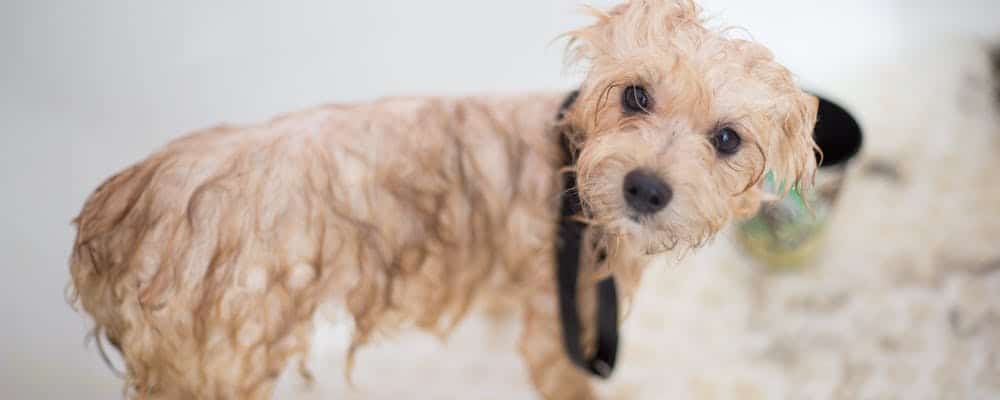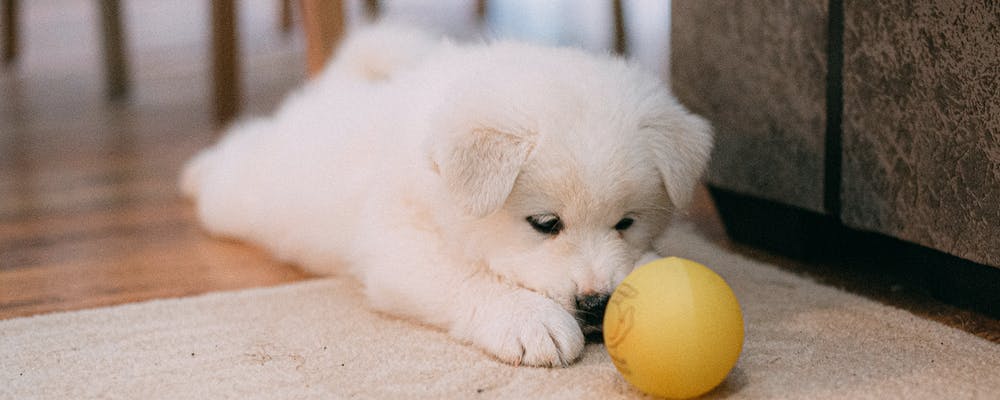How To Make Your Dog Love Bath Time
A regular bathing and grooming routine is just as important for dogs as it is for humans. However, while most dogs love swimming in pools and lakes many dogs have an aversion to taking any kind of a bath or shower. If you just got a new dog you will realize very quickly that they will begin to smell if their coat is not properly cleaned and maintained. Many pet owners will give up bathing their dog because the fight is not worth it to them. However, this is a poor long term strategy. Your dog’s coat and hygiene will suffer in the long term if you do not establish a normal bathing routine with your pup. In this article we will cover the main reasons dogs hate baths and how you can teach your dog to not only tolerate baths but actually enjoy them! We will teach you how to tell if your dog is afraid of water, has a problem with the temperature of your bath, is dealing with anxiety from a previous experience, or is having vision or balance issues in the tub based on their body language and behavior. Every dog is different, and some dogs may have multiple reasons why they do not like taking a bath. The suggestions provided below are not all encompassing for every dog. Think of these strategies as tools in the tool belt. Not every recommendation will work for every dog, but with a little trial and error we are confident you can get your dog to love bath time by testing the strategies outlined below.
1. Physical Contact During Bathing
If your dog constantly resists bath time one of the first things you should evaluate is how you physically interact with your dog. If you are giving your dog a bath you are most likely trying to hold them down to keep them from splashing suds around your bathroom walls or sporadically jumping out of the tub. Holding your dog down or in place can give them anxiety especially if they live with an abusive owner in the past. To test out this theory try bathing your dog in the shower or outside. That way they can roam a bit more and are not forced to be held in place.
Additionally, your pup may not like the sensation of being scrubbed or having their coat combed… especially on certain parts of their body. If your dog dislikes being pet on certain parts of their body they will likely have issues with scrubbing. Try gently rinsing your dog with water to see if they resist. In many cases dogs will enjoy being rinsed off if they are not scrubbed. If you find this to be the case with your pup try easing into bathtime with a gentle exfoliating brush and working your way up to a scrub.
2. Where To Wash Your Pup: The Bath, Shower, or Outdoors?
Where do you bathe your dog? If you wash your pup in the bath or shower the slippery floor may be difficult for them to stand in. If your dog struggles to keep their balance they will likely resist being kept in that environment. Getting a slip resistant bath mat is a great way to improve your pups balance when cleaning them. If you have a small dog or large bath your pup may also have anxiety from not being able to see out of the tub.Try bathing them outside to see if this calms their nerves. Additionally,
3. Water Temperature
Unlike cats, most dogs love the water. Especially when entering the water is completely optional for them. If you try giving your dog a bath outside they may be resistant due to cold hose water. If you are giving them a bath inside the water may be too hot. While humans tend to like hot showers, dogs prefer lukewarm water. Before attempting to rinse off your dog, test the water yourself to make sure the water is around 100 degrees fahrenheit. Although breeds of dogs differ on water temperature preferences 100 degrees is a good gauge to use with any pup. If you insist on washing your pup outside, fill up a couple of buckets with lukewarm water to make your dog feel more comfortable.
Running water vs Still Water
Fear of running water can cause anxiety in many dogs. Try filling up the tub with lukewarm water before bringing your pup into the bathroom and see if their attitude towards bathing improves. Dogs have sensitive ears and a running faucet right next to could be too loud, especially if they have had a traumatic experience near water.
4. Soaps & Shampoos
Have you tried using multiple shampoos on your dog? In addition to having sensitive ears, dogs have extremely sensitive noses. If your pup does not like the smell of the shampoo you are using they will probably try everything in their power to escape the tub! In order to cajole your pup into getting a bath trying keeping the soap out of their face. Soapy water frequently getting in your dog’s eyes or mouth could create negative associations with bath time.
Dogs with sensitive skin may also resist seemingly normal shampoos that aggravate their coat. If your dog suffers from dermatitis or any other type of skin condition consult with your vet to find a shampoo that nourishes your dog’s skin and coat. Many dog shampoos are overly aggressive and use harsh ingredients or chemicals to try and eliminate bad smells entirely out of your dog’s coat. If your dog has sensitive skin, natural and oatmeal based soaps are a great way to keep them clean while keeping their skin hydrated. Below we have listed some of the top shampoos for dogs with sensitive skin.
5. Calm your dog before bath time
A dog’s attitude before bath time plays a big role in how enthusiastic they will be during the actual bath. Instead of marching your dog straight into the bathroom, play with their favorite toy, take them on a walk, or give them a belly rub. Ideally you will be able to tire your pup out a bit before giving them a bath. If your dog still resists after building these positive associations, talk to your vet about different supplements you can use to help combat their anxiety. Many times dogs with anxiety can benefit from amino acids and nootropics to help keep them calm without making them drowsy or lethargic.
6. Other Incentives To Convince Your Dog To Take a Bath
If all else fails and your dog still puts up a fight to take a shower you may need to resort to a bribe. Depending on how rebellious you pup is it may be a fight just to get them in the bathroom. If this is the case, start by putting treats in the bathroom and leave the door open. By making entry into the bathroom optional your pup is a lot more likely to enter. After doing this several times dogs will begin to build a positive association with the bathroom as the place they get treats! Once your dog gets comfortable in the bathroom, start placing treats in the tub or shower to build a sense of comfortability in the environment.
Another strategy is to coat the walls of your tub with peanut butter. This will not only entice your dog to get in the tub, but will distract them as you bathe them. If you do not want to coat the walls of your tub with peanut butter you can give your dog a treat toy to play with while you give them a bath. This not only distracts your dog but gives them a mentally stimulating task during bath time. If you want to get your dog a special bath time toy check out our customized list to see our top rated picks for bath toys for dogs.
7. Join Your Pup For a Bath
Although it may sound weird, joining your pup in the bath is one of the best ways to keep them calm. Even letting your dog watch you shower is a great way for them to see that bathing is healthy and nothing to be scared of. If you have the time to get a little wet throw on a bathing suit and get in the tub with your pup!
8. Desensitization & Counterconditioning
Desensitization & Counterconditioning are powerful strategies pet parents and veterinary behavior therapists can use to change ingrained behaviors in dogs. Desensitization is the process of slowly exposing your dog to a stressor or anxiety provoking stimulus to begin dismantling the negative association. This is a great strategy for adopted dogs that may have been in abusive homes in the past. An example of desensitization is bringing your dog into the tub with a treat but not actually giving them a bath. This exposes them to the environment and will make them more calm in the bathroom. Counterconditioning is the process of changing your dog’s feelings about a stimulus by giving them a reward before the stimulus that causes anxiety. An example would be giving your dog a treat before and after a bath. This will build a positive association with getting a bath and will make many dogs who previously hated baths look forward to getting groomed.
Positive vs. Negative Associations When Dealing with a Pet
A big part of training and building a real relationship with any new pet is positive and negative associations. Your pet may be slow to trust you depending on their history with previous owners. The key is to never build negative associations or punish your dog. Punishments and negative associations are likely to increase the anxiety a misbehaving dog is already feeling. The key to a well behaved dog is always speaking to them in a gentle soothing voice and making sure they feel loved and appreciated.
9. Veterinary Behavior Therapists, Groomers & Last Resorts
If you try all of the above strategies and still can not get your dog to take a bath without inciting severe anxiety, take them to the vet. Your vet may be able to prescribe a special supplement, medicine, or diet that can help calm your dog down and make them more open to bathing. Your dog may also benefit from a behavior training class that will allow a professional to work with your pet and use clinically proven strategies to get them used to a normal grooming routine.
If bathing your pet is too much of a hassle it may make more sense to take them to a groomer. This prevents your dog from making a mess in the bathroom and saves you the stress from having to struggle bathing your dog.




